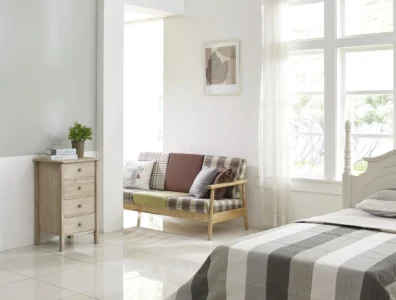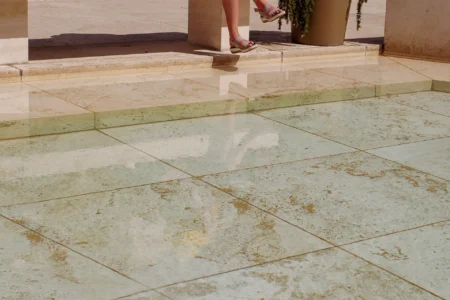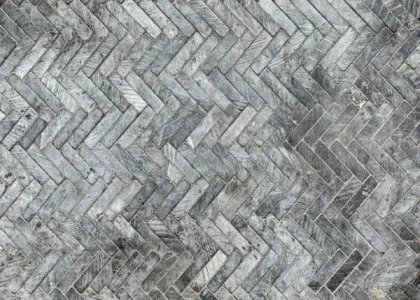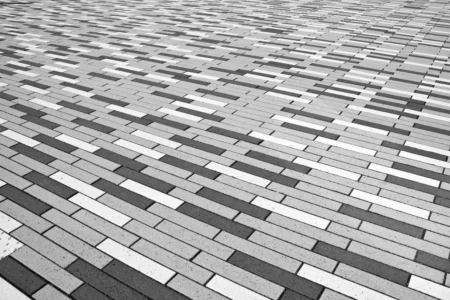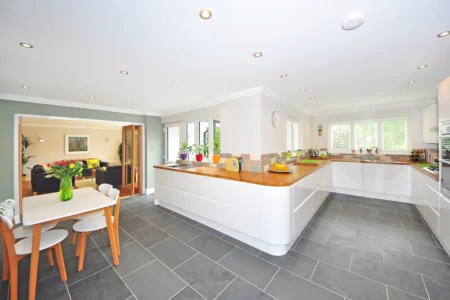Natural stone floor tiles would be one of the most elegant, sophisticated things that could be used in a home. These absolute durable, versatile, beautiful flooring options will blend with any color, style, or home fashion that is being used throughout the home. Many different styles and colors are available to choose from when selecting natural stone tiles. However, selecting the perfect natural stone tiles for your home could be a task full of challenges considering all the factors which typically consist of the type of stone, color, size, finish, installation and care. This article is meant to assist you in choosing natural stone floor tiles for your dwelling and give some instructive advice and examples.
Find the Right Natural Stone Material
When going for a natural stone floor at your home, the initial process of installation involves selecting the type of stone material to use. There are quite a number of varieties of natural stone materials such as marble, granite, limestone, travertine, slate, and sandstone amongst others. Various stones have various properties, benefits, and drawbacks when it comes to their appearances, durabilities, porosities, absorptions, hardnesses, slip resistances, and costs. Below are mentioned some of the most common natural stone tiles used for flooring along with their suggestion and characteristics:
- Marble: Marble is undoubtedly one of the most luxurous and elegant natural stone with an outstanding polished surface. There are many shades of marble — from brilliant white to deep ebony. In addition, marble is quite durable and it does not scratch easily or withstand heat. Marble is also highly porous and vulnerable to stains and etching from acid based foods or drinks. Just like marble, this flooring material must be sealed and coated periodically if you want your floors to remain good looking and undamaged.
- Granite: The other hard and dense natural stone is granite. In cases of kitchens or hallways that may attract lots of traffic, granite becomes a perfect fit because of its excellent resistance to marks, scratches and even wear. The granites do have such a variety of colors as well as patterns including speckled or veined.
- Limestone: Limestone is a beautiful natural stone, with an untouched look and feel. Limestone ranges from light yellow to dark brown via several shades of beige and gray. In addition, limestone is strong and flexible, thus allowing for its use in interior or exterior settings. Additionally, limestone is also cheaper than other commonly used natural stone types. On the other hand, the limestone contains many pores that are capable of absorbing moisture, thus making it prone to stains and cracks caused by frozen water. Just like limestone, it is advisable that it be regularly sealed and cleaned in order to protect itself from wearing out.
- Travertine: Travertine exhibits a porous surface having natural holes and pits creating distinctive character. Travertine is available in various colours including cream, ivory, gold and brown to mention a few. Travertine is also hardwearing and suitable for interior or exterior application. However, just like limestone, travertine is permeable or absorptive.
Varieties of Natural Stone Floor Tiles Designs
Another factor to consider when choosing natural stone floor tiles is the design or the style of the tiles. Natural stone floor tiles come in various shapes, sizes, finishes, and patterns that can create different effects and moods in your home. Here are some of the most common varieties of natural stone floor tiles designs and their features:
- Square or rectangular tiles:The most classical and traditional shapes of natural stone floor tiles produce simple yet classy appeal in your house. Tiles can be square or rectangular and come in different patterns like straight, diagonal, herringbone, or a basket weave. The size of square or rectangular tiles also ranges from small mosaic to large slabs. Any space within a house can be accommodated by square or rectangular tiles which can also fit different styles and decor.
- Hexagonal or octagonal tiles: They are more geometrical and modern and they can add an interesting and dynamic twist to your home with natural stone flooring tiles that create a stylish design statement with their different shapes. Honeycomb, starburst, or checkerboard patterns can be used as the installation scheme for hexagonal or octagonal tiles. Small up to large hexagonal or octagonal tiles. Hexagonal or octagonal tiles will spice the floor of a bathroom, kitchens or hallways.
- Irregular or random tiles: Such natural and organic shapes of natural stone floor tiles may create a relaxed and rural mood in your house. These are typically irregular or randomly cut tiles of large chunks of natural stones, whose edges and surfaces are not uniform. These irregular or randomly laid tiles can be arranged in different patterns but they should always be regularly sealed and filled to avoid damages and make it look attractive. It is slightly costly compared with other natural stones.
- Slate: Slate is a rock which consists of layers and has a rough surface. Slate is available in different colors including black, gray, green, and red. In addition, slate is very tough and impervious to stains, scratches, dents, and fractures. Also, slate is ideal for indoors and outdoors because of being tolerant toward variations in temperature and moisture. Likewise, slate is simple to clean and keeps, because it needs neither sealing nor polishing. Nonetheless, slate is also quite heavy and could be hard to cut and install.
- Sandstone: Sandstone is a natural stone that looks soft and warm. Sandstone exists in different colors like yellows, oranges, pinks, or even browns. This sandstone is so versatile that it can be used in interiors as well as exterior walls. Sandstone is also one of the cheaper natural stones. Despite this, sandstone is porous and absorbent, which makes it prone to staining by water and weather. Sealing and cleaning should be carried out on a routine basis for sandstone, so as to avoid damage.
As you can see, each type of natural stone has its own pros and cons, and you should choose the one that best suits your needs, preferences, budget, and style. In addition, you need to think about the size, form, and texture of the tiles since they will impact on how your room will appear. For instance, bigger tiles can make a small room appear larger and smaller ones can add details and texture. In addition, polished tiles produce a gleam like effect, whilst honed ones are dull and earthy.
Varieties of Natural Stone Floor Tiles Designs
Another aspect of choosing natural stone floor tiles is to decide what kind of design you want to create with them. There are many ways to arrange and combine natural stone tiles to create different patterns, styles, and effects. Here are some of the most common varieties of natural stone floor tiles designs:
- Solid: This is the simpliest and the classical design where you use one kind of natural stone tile one color for the whole floor. This is able to develop uniform and stylish look, which reveals natural stone beauty.
- Mixed: This is where you incorporate two or more types of natural stone tiles in different colors or patterns for the floor. This can help add some contrast and variety that helps increase the interest and character of space.
- Mosaic: Here, you make use of bits of natural stone tiles in different shapes, colored and patterns so as to create an overall larger design or picture on the floor. It could be used to provide a striking yet artistic appearance that attracts attention and praise.
- Border: This is where you use one type of natural stone tile for the main part of the floor, and another type of natural stone tile for the edges or corners of the floor. This can create a frame or outline that defines your space and adds more dimension.
- Inlay: When you employ the same kind of natural stone tile for the body of the floor, you should use another kind of the natural stone tile for covering the background of the floor. It will help to create a focal point, which will make your space more spacious and emphasize it.
As mentioned, these are a few ideas of what you can do with your natural stone floor tiles. Likewise, by pairing together different types, sizes, shapes, hues and surfaces of natural stone tiles, you can make up some personalized design. Also, it is prudent that you consider involving an expert tile installer or designer to assist you in planning and implementation of the project of natural stone floor tile.
Maintaining and Cleaning Natural Stone Floor Tiles
The last step in choosing natural stone floor tiles is to consider how to maintain and clean them. Natural stone floor tiles are durable and long-lasting, but they also require proper care and attention to preserve their beauty and quality. Here are some of the general tips and guidelines for maintaining and cleaning natural stone floor tiles:
- Seal your natural stone floor tiles regularly
This is a process of adding a barrier on the stone to act as protection against water, dirt, germs, and stains. It can also make the natural stone tiles more colorful and shining through sealing. Natural stone floor tiles must be sealed at least once a year, more often if they have heavy traffic, or are exposed to water or chemical substances. A water-based or a solvent-based sealer can be used depending on the stone type and as per the manufacturer’s advice. - Sweep or vacuum your natural stone floor tiles daily
Sweeping or vacuuming will clean dust, sand and other debris that may cause scratches or ruin the surfaces of the natural stone tiles. To prevent damage, use a soft-bristled broom or a vacuum cleaner with soft attachment when cleaning the natural stone tiles. - Mop your natural stone floor tiles weekly
You may use this type of cleaning to eliminate spills/stains/grease and grime, which in turn would discolor or damage the tiles. Warm water with a mild detergent or specific cleaner are applicable for damp mopping of natural stone tiles. Ensure you do not use acidic, abrasive, and harsh cleaners that can easily etch or corrode the natural stone tiles. You should also run water over the mop regularly to prevent the tiles’ natural stones from being contaminated by dirt and grime. - Dry your natural stone floor tiles after mopping
After mopping your natural stone floor tiles, dry them. If left unchecked, this can result in water spots, streaks and mold on the natural stone tiles as a consequence of drying. You should be using a soft piece of cloth or a microfiber towels to clean any remaining water from the natural stone tiles. It is critical not to leave wet mats or rugs on the natural stone tiles that can trap moisture and result in damage.
- Polish your natural stone floor tiles occasionally
In this case, polishing will help bring back the sheen and glow of the natural stone flooring tiles that have lost their original colour with age. A polishing compound or a polishing pad is applied on the natural-stone tiles until there is sufficient amount of glossiness. While polishing the natural stone floor tiles, you should always follow the manufacturer’s instructions and recommendations.
By following these tips and guidelines, you can keep your natural stone floor tiles clean and beautiful for years to come.
Conclusion
Using natural stone floor tiles is one of the best ideas that a homeowner would decide to add a touch of nature and beauty in his home. The natural stone floor tile has everything one would consider – durability, versatility and beauty while complementing virtually every style and decor. Choosing the right natural stone floor tiles for your home, however, calls for some research and planning as is such a case one needs to be guided by so many things which include the type of the stone, the color, the size, the finish, the installation, and the maintenance. In this article, we have given you some tips and examples in the selection of your home’s natural stone floor tiles. We hope that this article proves helpful and informative, and we would like to also wish you the best of luck during your natural stone floor tile project.
FAQs
Which natural stone is best for flooring?
The best natural stone for flooring largely depends on the specific needs of the space. Granite and quartzite are excellent for high-traffic areas due to their durability, while marble and limestone provide a classic and elegant aesthetic suitable for formal or quieter spaces.
What is the most durable natural stone floor?
Granite is often considered the most durable natural stone for flooring due to its hard surface that resists scratching and staining. It’s an ideal choice for areas with high foot traffic like kitchens and hallways.
Is natural stone good for flooring?
Yes, natural stone is an excellent choice for flooring due to its unique aesthetic, durability, and ability to increase property value. It’s also eco-friendly and can last a lifetime with proper maintenance.
How long does natural stone flooring last?
With proper maintenance, natural stone flooring can last for several decades, and even a lifetime. Its longevity is one of the major advantages of choosing natural stone for flooring, making it a long-term investment for your home or property.



